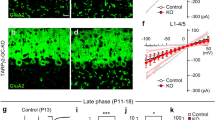Abstract
Neurons form exuberant synapses with target cells early in development. Then, necessary synapses are selectively strengthened whereas unnecessary connections are weakened and eventually eliminated during postnatal development. This process is known as synapse elimination and is a crucial step for shaping immature neural circuits into functionally mature versions. Accumulating evidence suggests that retrograde signaling from postsynaptic cells regulates synapse elimination, but the underlying mechanisms remain unknown. Here, we show that semaphorin3A (Sema3A) and semaphorin7A (Sema7A) mediate retrograde signals for elimination of redundant climbing fiber (CF) to Purkinje cell (PC) synapses in the developing cerebellum, a representative model of synapse elimination in the central nervous system. We picked up candidate retrograde signaling molecules that are expressed in PCs during the period of CF synapse elimination and the receptors of these candidate molecules that are present in CFs. We then assessed the effects of lentivirus-mediated RNAi-knockdown of these molecules on CF synapse elimination. By this systematic screening, we found that knockdown of Sema3A in PCs or its co-receptor, plexinA4 (PlxnA4), in CFs accelerated CF synapse elimination and decreased CF-mediated synaptic inputs. Conversely, knockdown of Sema7A in PCs or either of the two receptors for Sema7A, plexinC1 (PlxnC1) and integrinB1 (ItgB1), in CFs impaired CF synapse elimination. Importantly, the effect of Sema7A involves signaling by type 1 metabotropic glutamate receptor (mGluR1), a canonical pathway in PCs for the final stage of CF synapse elimination. These results demonstrate that specific semaphorins act as retrograde signaling molecules and regulate distinct processes of CF synapse elimination during postnatal cerebellar development.

Similar content being viewed by others
References
Hashimoto K, Kano M. Synapse elimination in the developing cerebellum. Cell Mol Life Sci. 2013;70:4667–80.
Hashimoto K, Tsujita M, Miyazaki T, Kitamura K, Yamazaki M, Shin HS, et al. Postsynaptic P/Q-type Ca2+ channel in Purkinje cell mediates synaptic competition and elimination in developing cerebellum. Proc Natl Acad Sci U S A. 2011;108:9987–92.
Kawamura Y, Nakayama H, Hashimoto K, Sakimura K, Kitamura K, Kano M. Spike timing-dependent selective strengthening of single climbing fibre inputs to Purkinje cells during cerebellar development. Nat Commun. 2013;4:2732.
Lichtman JW, Colman H. Synapse elimination and indelible memory. Neuron. 2000;25:269–78.
Lorenzetto E, Caselli L, Feng G, Yuan W, Nerbonne JM, Sanes JR, et al. Genetic perturbation of postsynaptic activity regulates synapse elimination in developing cerebellum. Proc Natl Acad Sci U S A. 2009;106:16475–80.
Nakayama H, Miyazaki T, Kitamura K, Hashimoto K, Yanagawa Y, Obata K, et al. GABAergic inhibition regulates developmental synapse elimination in the cerebellum. Neuron. 2012;74:384–96.
Watanabe M, Kano M. Climbing fiber synapse elimination in cerebellar Purkinje cells. Eur J Neurosci. 2011;34:1697–710.
Crepel F. Regression of functional synapses in the immature mammalian cerebellum. Trends Neurosci. 1982;5:266–9.
Kano M, Hashimoto K. Synapse elimination in the central nervous system. Curr Opin Neurobiol. 2009;19:154–61.
Uesaka N, Uchigashima M, Mikuni T, Nakazawa T, Nakao H, Hirai H, et al. Retrograde semaphorin signaling regulates synapse elimination in the developing mouse brain. Science. 2014;344:1020–3.
Mikuni T, Uesaka N, Okuno H, Hirai H, Deisseroth K, Bito H, et al. Arc/Arg3.1 is a postsynaptic mediator of activity-dependent synapse elimination in the developing cerebellum. Neuron. 2013;78:1024–35.
Uesaka N, Mikuni T, Hashimoto K, Hirai H, Sakimura K, Kano M. Organotypic coculture preparation for the study of developmental synapse elimination in mammalian brain. J Neurosci. 2012;32:11657–70.
Hashimoto K, Ichikawa R, Takechi H, Inoue Y, Aiba A, Sakimura K, et al. Roles of glutamate receptor δ2 subunit (GluRδ2) and metabotropic glutamate receptor subtype 1 (mGluR1) in climbing fiber synapse elimination during postnatal cerebellar development. J Neurosci. 2001;21:9701–12.
Kano M, Hashimoto K, Kurihara H, Watanabe M, Inoue Y, Aiba A, et al. Persistent multiple climbing fiber innervation of cerebellar Purkinje cells in mice lacking mGluR1. Neuron. 1997;18:71–9.
Pasterkamp RJ, Giger RJ. Semaphorin function in neural plasticity and disease. Curr Opin Neurobiol. 2009;19:263–74.
Acknowledgments
The authors thank A. Nienhuis, St. Jude Children’s Research Hospital and George Washington University for the gifts of the lentiviral backbone vector and the packaging plasmid; K. Kitamura and K. Hashimoto for helpful discussions; and K. Matsuyama, M. Sekiguchi, S. Tanaka, and A. Koseki for technical assistance. This work was supported by Grants-in-Aid for Scientific Research (19100005 to M.W. 21220006 and 25000015 to M.K. and 23650160 to N.U.), the Funding Program for Next Generation World-Leading Researchers (LS021) to H.H., the Strategic Research Program for Brain Sciences (Development of biomarker candidates for social behavior), and the Global COE Program (Integrative Life Science Based on the Study of Biosignaling Mechanisms) from MEXT, Japan.
Conflict of Interest
The authors declare that there are no conflicts of interest in the submission of this manuscript to The Cerebellum.
Author information
Authors and Affiliations
Corresponding author
Rights and permissions
About this article
Cite this article
Uesaka, N., Uchigashima, M., Mikuni, T. et al. Retrograde Signaling for Climbing Fiber Synapse Elimination. Cerebellum 14, 4–7 (2015). https://doi.org/10.1007/s12311-014-0615-y
Published:
Issue Date:
DOI: https://doi.org/10.1007/s12311-014-0615-y




